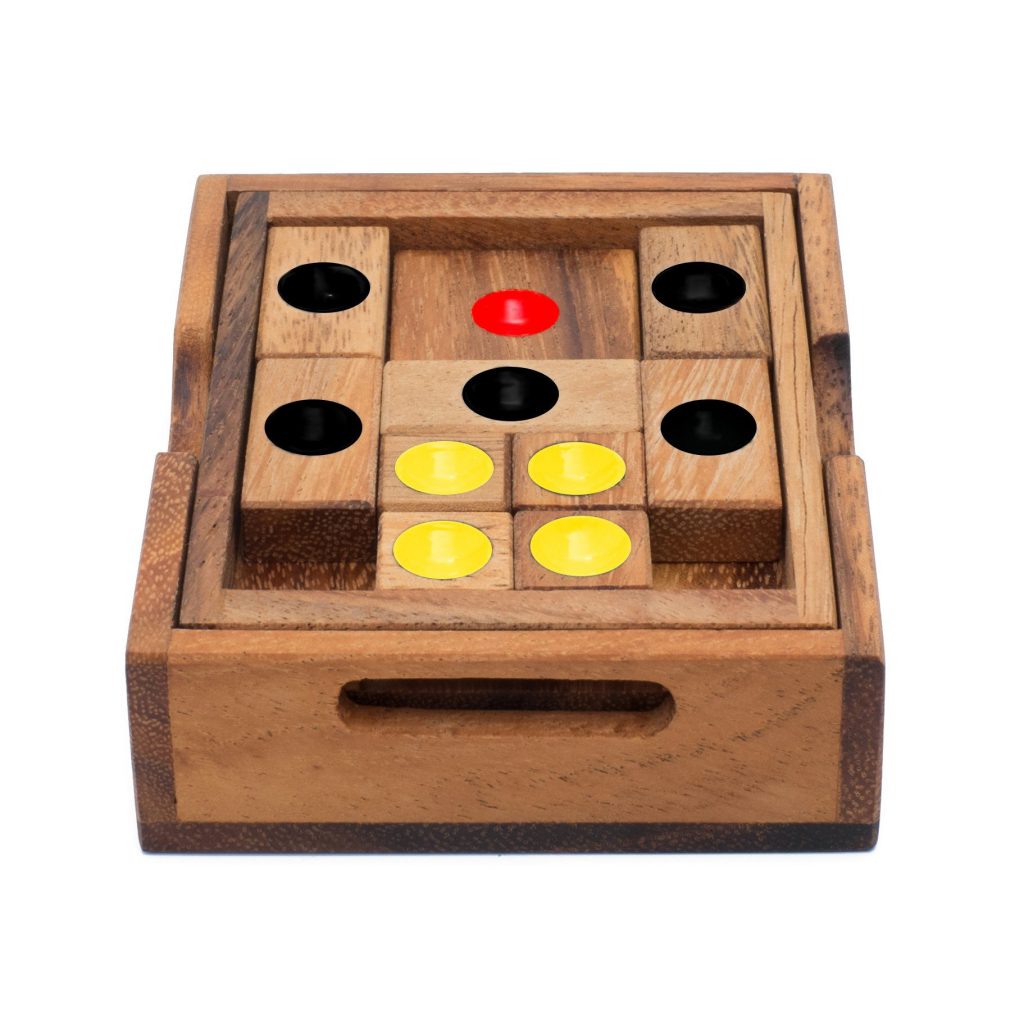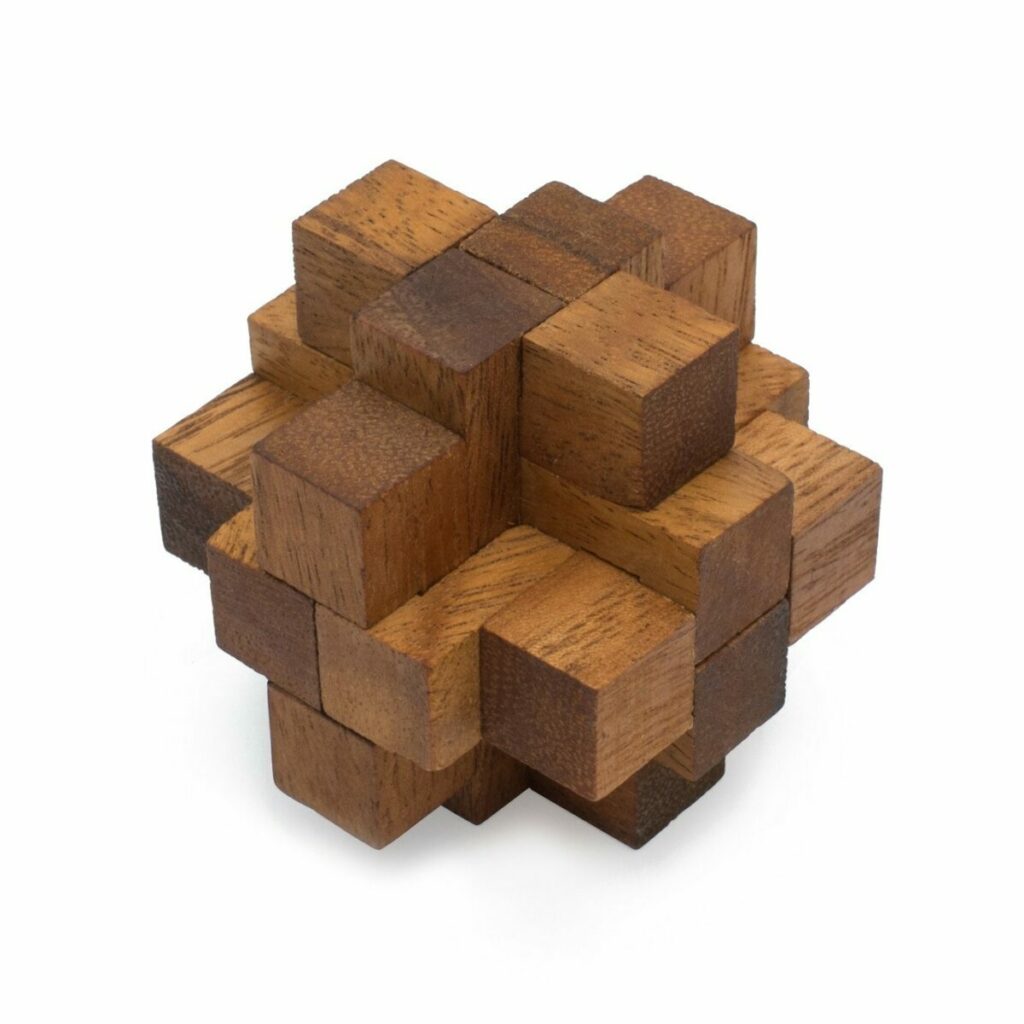SiamMandalay’s Wooden Puzzles Difficulty Levels Explained:
We spend a lot of time thinking about puzzle difficulty - how do we group them, who are they suitable for?
Below are factors we consider when thinking about the level of difficulty a puzzle possesses, they were wonderfully outlined in a cleverwood article:
- The puzzle’s number of pieces
- The puzzle’s number of moves
- The puzzle’s number of unique non-repetitive moves
- The puzzle’s complexity
- The number of solutions possible
- The puzzle similarity to other puzzles
- Misleading tricks into the puzzle
- Clues built into the puzzle
- The skills, knowledge and abilities of the solver
- Solvers experience
We would also like to add:
- Logic Spectrum – how illogical or logical are the moves?
Difficulty ratings are a hard nut to crack and their relevance to overall puzzle enjoy ability is also debatable.

Setting Sun
When you are discussing dissimilar puzzles, take for example comparing a disentanglement like Orbits and compare it to a tile puzzle, like Setting Sun. It is advisable therefore for you to group puzzles together based their variation IE: Burr Puzzle, Sliding Puzzle or an interlocking puzzle then you can contrast and compare the difficulty a little easier.
It also follows that somebody with experience within a particular ‘type’ of puzzle will probably find similar puzzles easier – you can often become better a puzzler just through practice.
The number of moves required to complete seems like a very practical place to start when defining difficulty. When you For example a Burr puzzle that requires 6 moves, should be easier than the 128-move burr puzzle – Supernova.

Supernova
Jerry Slocum provided this insight:
"It seems to me that the dimension of difficulty is more related to the number of TYPES of moves, rather than just the number of moves. In many classical Japanese puzzle boxes, the same type of move is used every time. For these trick boxes adding additional moves adds very little or no additional difficulty in opening the box. But if the box includes different types of moves, such as moving a piece back rather than forward, or moving a piece only part way to the end of its path, it makes the trick box significantly more difficult.”
Also, the number of moves shouldn’t define a difficult puzzle – consider the classic pyramid puzzle, regarded as one of the great puzzles, due to the few amount of moves and pieces at your disposal – yet still proving to me troublesome.
Still, the number of pieces will also play a role in the difficulty of a puzzle at least in a means of confusion especially in sequential move puzzles.
The logic spectrum is interesting as different – as some people prefer wholly logical moves and find them more satisfying and difficult, whereas illogical moves sometimes provide for more complex solutions – our snake cube set of 6 for example consists of cubes that have illogical sequences.
The number of unique moves aligns itself with the inability to find a pattern if moves are unique, non-repetitive and illogical – this would lend itself to a complicated puzzle.
Experience – puzzles are special in that they you can master their methods and learn their nuances. By developing skills on a particular theme of puzzles you can work specific parts of your brain and learn new techniques. The more you practice the better you will work.
Depending on the puzzle style, clues can add to the overall narrative of the puzzle, although it would be hard to argue that giving clues actually reduces the puzzles difficulties. Unless they are red herrings.
SiamMandalay rank all our puzzles in a system that goes 1 through 3, 1 being the easiest; 3 being the most difficult. The most troublesome element when calculating the difficulty of wooden puzzles is “difficulty” is purely subjective idea.
The beauty of puzzles is that they take a wide variety of differing skill sets. You may feel that a particular puzzle is difficult, but someone else may find it easy. Mainly it is subjective due to experience.
Even considering this, there are some basic factors which formulate a ‘difficult’ puzzle as opposed to an ‘easy one’.
Rating 1 – this is for a beginner, usually for fun or a precocious child. We also have small children’s toys.
Rating 2- for a semi-serious adult or teenager, usually more complex.
Rating 3 - for serious puzzlers – get puzzling.



